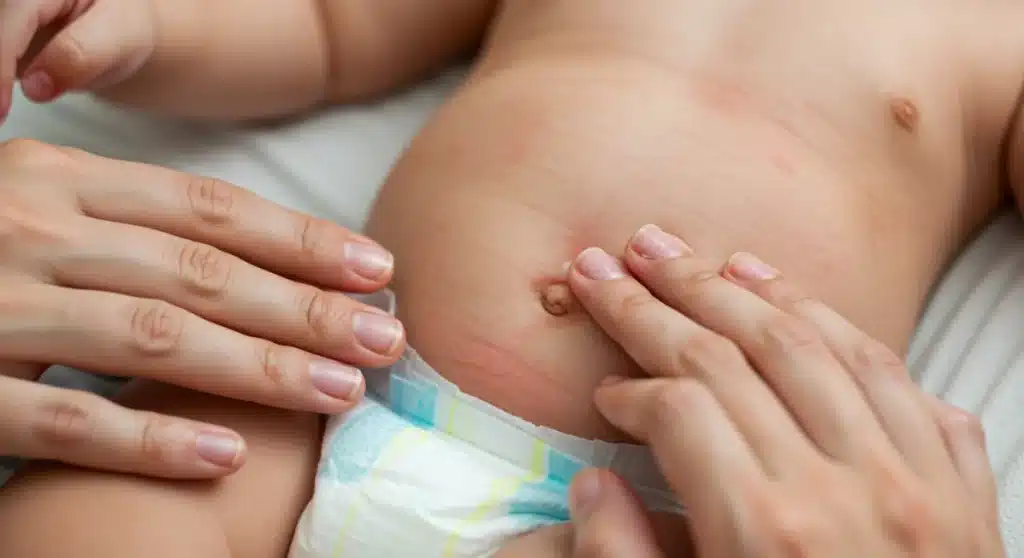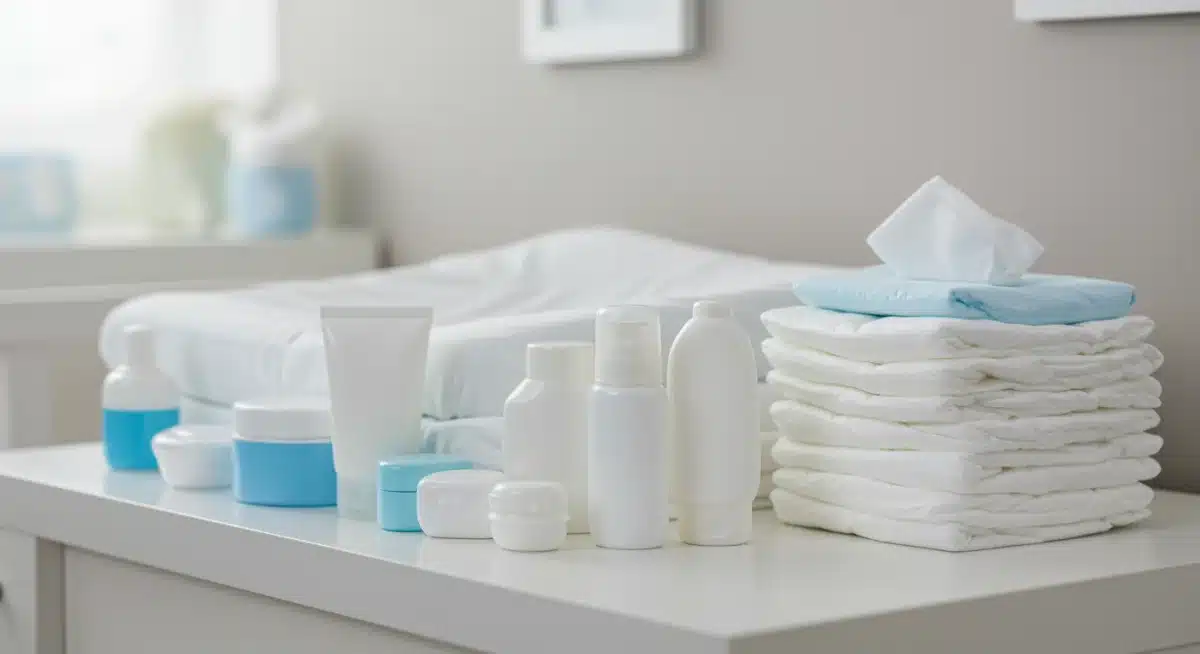Diaper Rash Remedies: Soothing Your Baby’s Irritated Skin

Advertisement
Effectively addressing diaper rash involves understanding its causes, implementing preventative measures, and utilizing appropriate remedies to soothe your baby’s irritated skin, ensuring comfort and promoting healing.
Navigating the world of new parenthood brings immense joy, but also its share of common challenges. Among these, few are as universally experienced, or as distressing for both parent and baby, as diaper rash. Understanding effective diaper rash remedies and how to implement practical solutions can make all the difference in soothing your baby’s irritated skin.
Advertisement
Understanding Diaper Rash: Causes and Identification
Diaper rash, medically known as irritant diaper dermatitis, is a common inflammatory skin condition that affects infants and toddlers. It typically manifests as redness, tenderness, and sometimes small bumps or peeling skin in the diaper area. While often mild, it can cause significant discomfort for your little one, leading to fussiness and interrupted sleep. Recognizing the signs early and understanding the underlying causes are the first steps toward effective management.
The primary culprit behind most diaper rashes is prolonged exposure to wetness and friction. A diaper, by its very nature, creates a warm, moist environment – a perfect breeding ground for irritation and, in some cases, microbial growth. However, several other factors contribute to its development and severity.
Common Causes of Diaper Rash
Beyond simple wetness, various elements can trigger or exacerbate diaper rash. Identifying these can help parents tailor their prevention and treatment strategies effectively.
Advertisement
- Moisture: Urine and feces, especially when left in contact with the skin for too long, contain enzymes and chemicals that break down the skin’s natural barrier.
- Friction: The rubbing of the diaper against sensitive skin can cause mechanical irritation, especially in active babies.
- Chafing: Tight-fitting diapers or clothing can increase friction and reduce air circulation, trapping moisture.
- Irritants: Certain chemicals in baby wipes, detergents used for cloth diapers, or even ingredients in some bath products can irritate delicate skin.
- New Foods: Introducing solid foods can change the composition and frequency of your baby’s stools, sometimes leading to more acidic or frequent bowel movements that irritate the skin.
- Antibiotics: Antibiotics can disrupt the natural balance of bacteria in the gut, leading to diarrhea and increasing the risk of yeast infections, which often manifest as a type of diaper rash.
- Yeast Infections: A common complication, candidiasis (yeast infection) thrives in warm, moist environments. It often presents as bright red, raised patches with small red satellite lesions extending beyond the main rash area.
Understanding these causes is crucial for both prevention and treatment. A mild rash might simply require increased air exposure and a good barrier cream, while a rash caused by a yeast infection will need specific antifungal treatment. Observing the characteristics of the rash and your baby’s recent activities, such as diet changes or medication, can provide valuable clues.
First Line of Defense: Prevention Strategies
As with many conditions, prevention is often the most effective approach when it comes to diaper rash. Implementing a consistent routine of good diaper hygiene can significantly reduce the likelihood of your baby developing irritated skin. These strategies focus on minimizing moisture, reducing friction, and protecting the skin’s delicate barrier.
Key Preventative Measures
A proactive approach to diaper care involves several simple yet powerful habits that can keep your baby’s skin healthy and happy.
- Frequent Diaper Changes: This is arguably the most critical preventative step. Change wet or soiled diapers as soon as possible. For newborns, this might mean every 1-3 hours, and for older infants, it could be every 2-4 hours, or immediately after a bowel movement.
- Gentle Cleaning: Use warm water and a soft cloth or fragrance-free, alcohol-free wipes to clean the diaper area. Always wipe from front to back to prevent the spread of bacteria, especially in girls.
- Thorough Drying: After cleaning, gently pat the skin completely dry before putting on a new diaper. Do not rub, as this can cause further irritation. Air drying for a few minutes can also be highly beneficial.
- Barrier Creams: Apply a thick layer of a zinc oxide or petroleum jelly-based barrier cream at every diaper change. These creams create a protective layer on the skin, shielding it from moisture and irritants.
- Proper Diaper Fit: Ensure diapers fit well, neither too tight nor too loose. A too-tight diaper restricts airflow and increases friction, while a too-loose one can lead to leaks and increased skin exposure to waste.
- Allow for Air Exposure: Whenever possible, let your baby go diaper-free for short periods. This allows the skin to breathe and dry completely, which is excellent for prevention and healing.
By consistently following these preventative measures, parents can significantly lower the risk of diaper rash and maintain their baby’s skin health. These simple routines are not just reactive treatments but essential components of daily baby care, promoting comfort and well-being.
Effective Home Diaper Rash Remedies
When diaper rash does appear, even with the best preventative efforts, knowing how to treat it at home can bring quick relief to your baby. Most mild to moderate rashes respond well to consistent home care, focusing on keeping the area clean, dry, and protected. It’s about creating an optimal healing environment for their delicate skin.
Top Home Treatments for Irritated Skin
Several tried-and-true methods can effectively soothe and heal typical diaper rashes. The key is consistency and patience.
- Increased Diaper-Free Time: This is paramount. Allowing your baby to go without a diaper for as long as possible (e.g., during naps on a waterproof pad, or even just for 10-15 minutes after each change) helps the skin air out and dry completely, which is crucial for healing.
- Barrier Ointments: Zinc oxide (found in many popular diaper rash creams) and petroleum jelly are excellent choices. Apply a thick layer at every diaper change. Zinc oxide provides a strong barrier and has mild astringent properties, while petroleum jelly creates a protective, moisturizing seal.
- Frequent, Gentle Cleaning: Continue changing diapers frequently and cleaning the area gently with warm water and a soft cloth. Avoid harsh scrubbing or wipes with alcohol or fragrance if the skin is already irritated, as these can sting and worsen the rash.
- Lukewarm Baths: A short, lukewarm bath can be soothing. Avoid bubble baths or harsh soaps. Pat the area dry very gently afterward, or even air dry. Some parents find adding a small amount of colloidal oatmeal to the bath water can further soothe inflamed skin.
- Avoid Tight Clothing: Dress your baby in loose-fitting clothes made from breathable fabrics like cotton. This helps air circulate around the diaper area and reduces friction.
Consistency in applying these home remedies is vital. It might take a few days for the rash to completely clear up, but you should see improvement within 24-48 hours. If the rash persists or worsens despite these efforts, it may indicate a more severe condition requiring medical attention.
When to Seek Professional Help for Diaper Rash
While most diaper rashes are mild and resolve with home care, there are instances when a pediatrician’s evaluation is necessary. Recognizing these red flags can prevent complications and ensure your baby receives the appropriate treatment. Trusting your parental instincts is important; if something feels off, it’s always best to consult a medical professional.
Signs That Warrant a Doctor’s Visit
It’s crucial to distinguish between a common irritant rash and something more persistent or severe. Here are the key indicators that it’s time to contact your pediatrician:
- No Improvement After 2-3 Days: If, despite consistent home remedies, the rash shows no signs of improvement within 48 to 72 hours, it’s time to consult a doctor.
- Worsening Rash: If the rash spreads, becomes more red, swollen, or painful, or if your baby seems to be in increased discomfort, seek medical advice.
- Blisters, Sores, or Pustules: The presence of open sores, pus-filled blisters, or boils could indicate a bacterial infection.
- Fever: If your baby develops a fever in conjunction with the diaper rash, it suggests a systemic infection that needs immediate attention.
- Unusual Appearance: Rashes that are bright red with distinct borders and satellite lesions (smaller red spots around the main rash) often point to a yeast infection, which requires antifungal medication.
- Severe Pain: If your baby cries inconsolably during diaper changes or seems to be in significant pain, a doctor should assess the situation.
- Rash Spreading Beyond Diaper Area: While unlikely for a typical diaper rash, if the irritation starts to appear on other parts of the body, it might be an indicator of a different skin condition.
Your pediatrician can accurately diagnose the type of rash and prescribe appropriate medications, such as antifungal creams for yeast infections or antibiotics for bacterial infections. Early intervention can prevent further discomfort and potential complications for your baby.
Advanced Treatments and Prescription Options
For diaper rashes that don’t respond to over-the-counter remedies or home care, a pediatrician might recommend or prescribe more advanced treatments. These typically target specific types of infections or more severe inflammation, providing relief where standard methods fall short. Understanding these options can help parents discuss treatment plans confidently with their doctor.

Prescription Medications and Specialized Care
When a diaper rash is persistent or complicated, simply changing diapers more often or using barrier creams may not be enough. This is where medical intervention becomes crucial.
- Antifungal Creams: If the rash is caused by a yeast infection (Candida), which is very common, your doctor will likely prescribe an antifungal cream like nystatin or clotrimazole. These are applied directly to the affected area and are highly effective in clearing up yeast-related rashes.
- Mild Corticosteroid Creams: In cases of severe inflammation or irritation, a very low-potency topical steroid cream, such as 0.5% or 1% hydrocortisone, might be prescribed for a short duration. These creams help reduce redness and swelling but should only be used under a doctor’s supervision due to potential side effects with prolonged use.
- Antibiotic Creams: If a bacterial infection is suspected (e.g., impetigo secondary to scratching), a topical antibiotic cream may be prescribed. Oral antibiotics are rarely needed for diaper rash but could be considered in very severe or widespread bacterial infections.
- Combination Products: Some prescription creams combine an antifungal, a mild steroid, and a barrier agent to tackle multiple issues simultaneously, particularly useful for mixed infections.
- Addressing Underlying Conditions: In rare cases, recurrent or severe diaper rash might be a symptom of an underlying medical condition, such as a food allergy, eczema, or an immune deficiency. Your pediatrician may conduct further tests or refer you to a pediatric dermatologist if these possibilities are suspected.
It is essential to follow your doctor’s instructions meticulously when using prescription medications. Do not self-medicate with leftover creams or products intended for other conditions, as this could worsen the rash or cause adverse reactions. Always complete the full course of treatment, even if the rash appears to clear up sooner, to prevent recurrence.
Long-Term Skin Health and Maintenance
Beyond immediate treatment, fostering long-term skin health in the diaper area is vital for preventing future occurrences of diaper rash. This involves maintaining good hygiene practices, making informed choices about products, and being attentive to your baby’s unique skin needs. A proactive and consistent approach ensures your baby’s comfort and reduces the stress associated with recurrent rashes.
Strategies for Sustained Diaper Area Well-being
Establishing a routine that prioritizes skin integrity will serve your baby well throughout their diaper-wearing years.
- Continue Good Diaper Habits: Even after a rash clears, maintain frequent diaper changes, gentle cleaning, and thorough drying. These are the cornerstones of preventing recurrence.
- Choose Hypoallergenic Products: Opt for diapers, wipes, and barrier creams that are fragrance-free, dye-free, and alcohol-free. Products labeled as “hypoallergenic” or “for sensitive skin” are generally safer choices for preventing irritation.
- Consider Different Diaper Brands: Sometimes, a particular brand of diaper might not agree with your baby’s skin due to materials or absorbency. If rashes are frequent, try switching to a different brand or even exploring cloth diapers, ensuring they are washed with gentle, baby-friendly detergents.
- Balanced Diet for Older Babies: As babies transition to solid foods, pay attention to how certain foods affect their stool. Acidic foods like citrus fruits or tomatoes can sometimes irritate the skin upon excretion. Introduce new foods one at a time to identify potential triggers.
- Monitor During Illness: Be extra vigilant with diaper care when your baby is ill, especially with diarrhea or when taking antibiotics. These situations significantly increase the risk of diaper rash.
- Educate Caregivers: Ensure anyone caring for your baby (grandparents, daycare providers) understands and follows your established diaper care routine. Consistency across all caregivers is key.
By integrating these practices into your daily routine, you can significantly contribute to your baby’s long-term skin health, minimizing the chances of future diaper rash episodes and keeping their delicate skin soft, smooth, and comfortable. Continuous observation of your baby’s skin and swift action at the first sign of irritation will also prevent minor issues from escalating.

The Role of Nutrition and Hydration in Skin Health
While external care is crucial, the internal environment also plays a significant role in your baby’s skin health, particularly in preventing and managing diaper rash. Nutrition and hydration contribute to the overall integrity and resilience of the skin barrier. What goes into your baby’s body can influence how their skin reacts to external irritants.
For breastfed babies, the mother’s diet can indirectly influence the baby’s gut health and, consequently, stool composition. For formula-fed infants, choosing the right formula and ensuring proper preparation is important. As babies grow and start solids, their diet becomes an even more direct factor in managing diaper rash.
Dietary Considerations for Diaper Rash Prevention
Thoughtful dietary choices can support healthy skin from within. This is especially true when introducing new foods or managing digestive upsets.
- Hydration: Ensuring your baby is adequately hydrated is fundamental. Water helps maintain skin elasticity and overall bodily functions. For infants, breast milk or formula provides all necessary hydration. For older babies on solids, offering sips of water is beneficial.
- Probiotics: For babies prone to yeast infections or those on antibiotics, probiotics can be beneficial. These beneficial bacteria help maintain a healthy gut flora, potentially reducing the incidence of diarrhea and yeast overgrowth. Consult your pediatrician before introducing any supplements.
- Fiber-Rich Foods (for older babies): As babies transition to solid foods, a diet rich in fiber (from fruits, vegetables, and whole grains) helps promote regular, well-formed bowel movements, which are less irritating to the skin than loose stools.
- Identify Food Sensitivities: Some babies may have sensitivities or allergies to certain foods that can manifest as digestive upset and more frequent, acidic stools. Keep a food diary if you suspect a link between certain foods and diaper rash. Common culprits can include dairy, soy, or highly acidic fruits.
- Avoid Excessive Sugars: A diet high in sugar can sometimes contribute to yeast overgrowth, both in the gut and on the skin. While naturally occurring sugars in fruits are fine, limiting added sugars in processed baby foods or drinks is a good practice for overall health and skin integrity.
By paying attention to your baby’s nutrition and hydration, you’re not only supporting their general health but also building a stronger internal defense against skin issues like diaper rash. A well-nourished body and a healthy gut contribute significantly to resilient skin, making it less susceptible to irritation and faster to heal when issues arise.
| Key Aspect | Brief Description |
|---|---|
| Prevention | Frequent changes, gentle cleaning, thorough drying, and barrier creams are essential for preventing diaper rash. |
| Home Remedies | Increase diaper-free time, use zinc oxide or petroleum jelly, and ensure gentle cleansing for mild to moderate rashes. |
| When to See a Doctor | Consult a pediatrician if rash worsens, doesn’t improve after 2-3 days, or shows signs of infection like blisters or fever. |
| Long-Term Care | Maintain hygiene, use hypoallergenic products, and consider dietary influences for sustained skin health and rash prevention. |
Frequently Asked Questions About Diaper Rash
The fastest way to clear a mild diaper rash is a combination of frequent diaper changes, thorough but gentle cleaning (pat dry), generous application of a zinc oxide barrier cream, and maximizing diaper-free time to allow the skin to air out completely.
Yes, introducing new foods, especially acidic ones like citrus or tomatoes, can alter stool composition and acidity, sometimes leading to diaper rash. Additionally, food sensitivities or allergies can cause digestive upset and more irritating stools, contributing to rash development.
Neither is inherently better or worse; it depends on management. Cloth diapers require diligent washing with gentle detergents and frequent changes to prevent irritation. Disposable diapers offer good absorbency but can still cause rash if not changed promptly or if the baby is sensitive to materials.
A regular diaper rash is typically red and inflamed, primarily in areas of contact. A yeast infection (Candida) often presents as bright red, raised patches with distinct borders, and characteristic small red spots (satellite lesions) extending beyond the main rash area, and it may not respond to standard diaper creams.
Barrier creams are excellent for both prevention and treatment. You can continue using a thin layer of a zinc oxide or petroleum jelly-based cream at every diaper change as a preventative measure even after the rash has cleared, especially if your baby is prone to irritation.
Conclusion
Mastering the art of preventing and treating diaper rash is an essential skill for any parent. By understanding the causes, implementing consistent preventative measures, utilizing effective home remedies, and knowing when to seek professional medical advice, you can ensure your baby’s comfort and promote healthy skin. Remember that every baby’s skin is unique, so a personalized approach, coupled with patience and vigilance, will be your best allies in keeping your little one happy and rash-free. Prioritizing gentle care and quick action will not only alleviate immediate discomfort but also contribute significantly to your baby’s overall well-being and long-term skin health.





